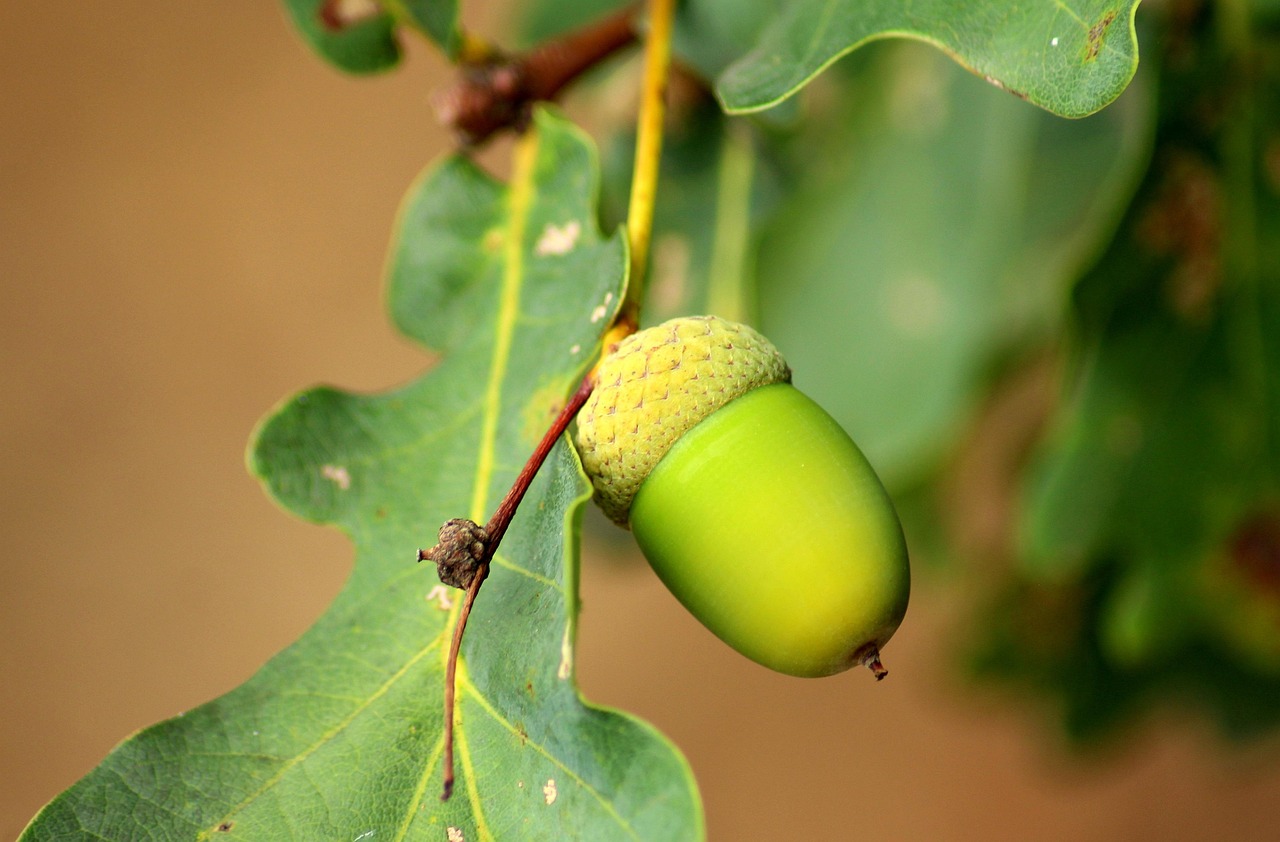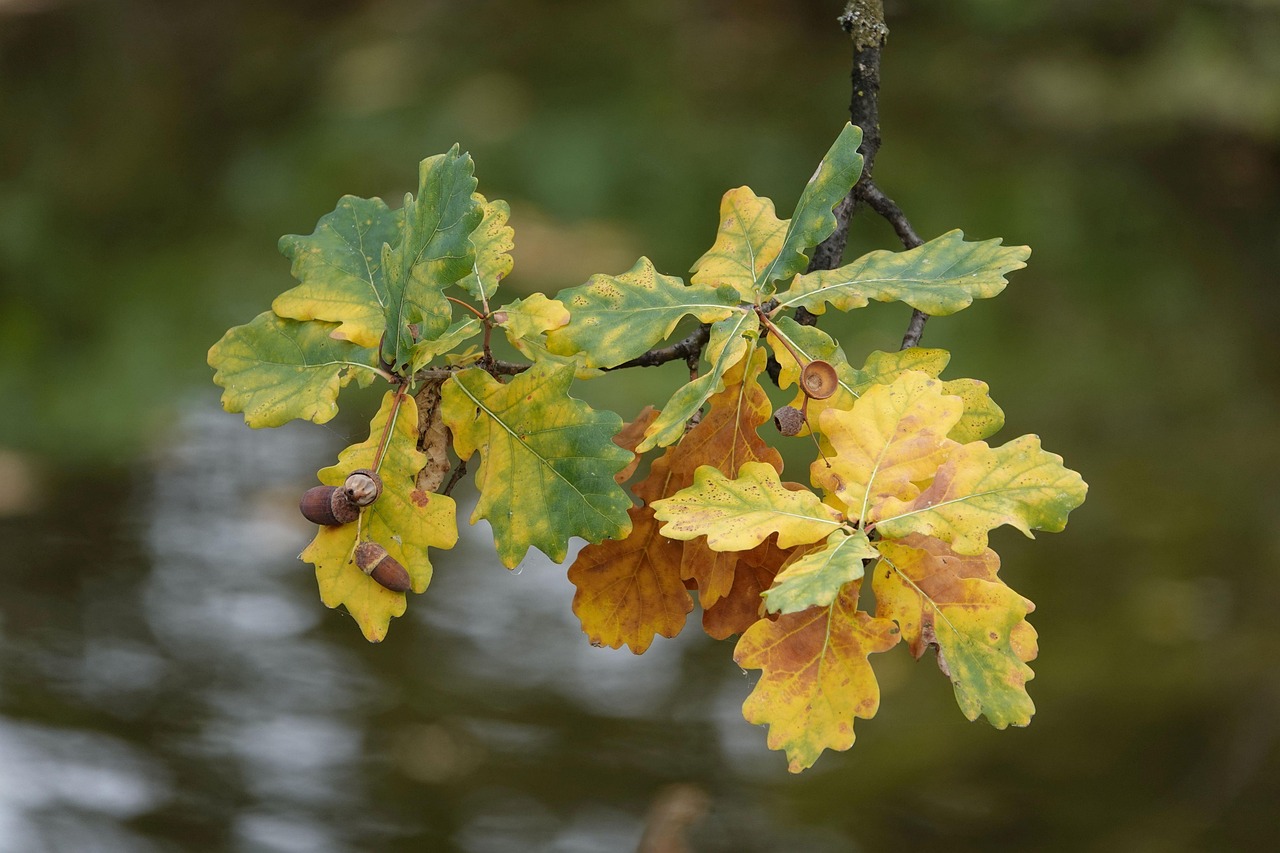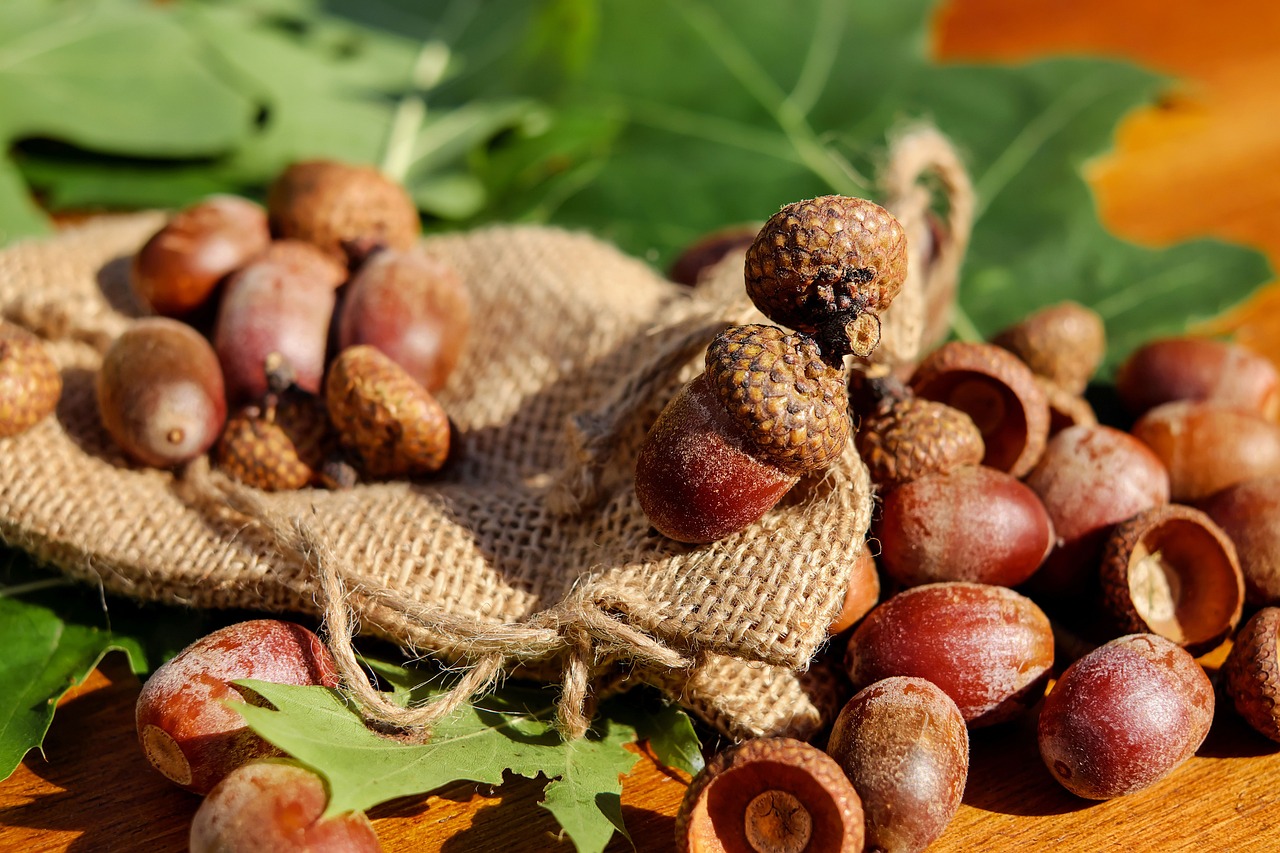Acorns typically drop from oak trees in the fall, with peak seed production occurring between late summer and early autumn, depending on the species and geographical location. This period can range from late August through October, with some variations based on climate and environmental factors.
Understanding Acorn Season

Acorns are the seeds of oak trees, and they play a crucial role in the life cycle of these majestic trees. The process of acorn production is a fascinating aspect of oak ecology. Oak trees are known for producing acorns in cycles, which can vary significantly from year to year. Some years witness a heavy crop, while others may see very few acorns. This cycle is often referred to as “masting.”
Masting is a survival strategy employed by oak trees to ensure that enough seeds survive predation. During a mast year, an abundance of acorns can overwhelm the animals that feed on them, increasing the likelihood that some will survive to germinate. This phenomenon can be influenced by various environmental factors, including weather conditions, soil health, and the age of the trees.
Factors Influencing Acorn Production
Several key factors affect when and how many acorns oak trees produce each year:
- Tree Age: Younger oak trees may produce fewer acorns than older, more established ones.
- Species: Different oak species have varying acorn production timelines. For example, White oaks tend to drop their acorns earlier than Red oaks.
- Weather Conditions: A warm spring and adequate rainfall can lead to a more abundant acorn crop.
- Pest and Disease Pressure: Infestations or diseases can reduce acorn production significantly.
The Acorn Life Cycle
The life cycle of an acorn begins when the tree flowers. Oak trees produce both male and female flowers. The male flowers release pollen, which fertilizes the female flowers. Once fertilization occurs, the acorns begin to develop over the summer months.
As autumn approaches, the acorns mature and prepare to drop from their parent trees. The timing of this drop can vary based on species:
| Oak Species | Acorn Drop Period |
|---|---|
| White Oak | Late September to Early October |
| Red Oak | October to Early November |
| Live Oak | Year-round with peaks in Late Summer and Fall |
The acorns fall to the ground, where they can either germinate immediately or enter a period of dormancy. This dormancy is essential for ensuring that the seeds do not sprout until conditions are favorable for growth. Factors such as temperature and moisture levels play a significant role in this process.
Ecological Importance of Acorns
Acorns serve as a vital food source for various wildlife species. Many animals, including squirrels, deer, birds, and insects, rely on acorns for sustenance. The abundance of acorns during the fall season supports these animals as they prepare for winter months when food becomes scarce.
In addition to their role in the food chain, acorns also contribute to forest regeneration. When they germinate, they grow into new oak trees, continuing the life cycle of these important forest giants. The health of oak populations is essential for maintaining biodiversity and ecosystem balance.
Understanding the Masting Phenomenon
The masting phenomenon is a remarkable aspect of oak trees and their reproductive strategy. This annual variation in acorn production can be observed across different oak species. Masting typically occurs in a cycle, where some years feature an abundance of acorns, while others yield very few. Understanding this pattern can provide insights into the health and dynamics of oak populations.
Types of Masting
Masting can be classified into two main types: proximate masting and ultimate masting.
- Proximate Masting: This occurs due to immediate environmental conditions, such as temperature, rainfall, and soil moisture levels. Favorable conditions during the flowering and fruiting periods lead to higher acorn production.
- Ultimate Masting: This refers to the long-term evolutionary strategy of oak trees. By producing large quantities of acorns in certain years, oak trees ensure that enough seeds survive predation by animals. It is a survival mechanism that increases the chances of some acorns germinating and growing into new trees.
Factors Affecting Acorn Production Cycles
The cycles of acorn production are influenced by a combination of biological and environmental factors. Some of the most significant include:
- Climate Variability: Changes in temperature and precipitation patterns can directly affect how many acorns an oak tree produces. For example, a warm spring followed by adequate rainfall can enhance acorn yield.
- Soil Nutrients: The quality of soil plays a vital role in the health of oak trees. Nutrient-rich soils tend to support better growth and higher acorn production.
- Pest Interactions: Insect infestations, such as those caused by the acorn weevil, can dramatically reduce acorn yield. These pests feed on the developing acorns, leading to lower numbers at harvest time.
The Role of Oak Species
Different species of oak trees have distinct reproductive habits and timelines for dropping their acorns. Here are some notable differences:
- White Oak (Quercus alba): Known for its sweet-tasting acorns, the White Oak typically drops its acorns from late September to early October. These acorns mature in just one growing season.
- Red Oak (Quercus rubra): This species has a longer maturation period, requiring two growing seasons before its acorns fall, usually between October and early November. They are often more bitter than White Oak acorns.
- Live Oak (Quercus virginiana): Unique among oaks, Live Oaks can produce acorns year-round, with peaks occurring in late summer and fall, depending on regional climate conditions.
Impact of Acorn Production on Wildlife

The impact of acorn production reaches far beyond the oak trees themselves. Numerous wildlife species depend on acorns as a primary food source. The fluctuations in acorn availability directly influence animal populations and behaviors:
- Squirrels: Both tree squirrels and ground squirrels rely heavily on acorns. They store them for winter, making them crucial for their survival.
- Deer: Acorns are a major part of a deer’s diet in the fall, providing essential nutrients before winter.
- Birds: Many bird species, including jays and woodpeckers, feed on acorns and play a role in dispersing them, helping new oak trees to grow.
- Insects: Various insects also thrive on acorns, contributing to the ecosystem by serving as food for other animals.
The intricate relationships between oak trees, their acorns, and the wildlife that depends on them highlight the importance of understanding the timing and quantity of acorn production. These interactions not only affect individual species but also shape entire ecosystems.

Human Interaction with Acorn Production
Humans have long recognized the significance of acorns and the oak trees that produce them. From their role in local ecosystems to their cultural and economic importance, acorns have a multifaceted relationship with human activities.
Historical Significance of Acorns
In many cultures, acorns have been a staple food source. Indigenous peoples across North America relied on acorns as a significant part of their diet. The acorns were often ground into flour or leached to remove tannins, making them more palatable. This historical reliance underscores the nutritional value of acorns and their importance in human survival.
- Culinary Uses: Today, chefs and culinary enthusiasts are rediscovering acorns as a unique ingredient. They can be used in various dishes, from soups to baked goods, bringing a nutty flavor to the table.
- Crafts and Art: Acorns have also been used in traditional crafts, such as jewelry making and decorations. Their unique shapes and colors lend themselves well to artistic expression.
Impact on Forest Management
The ecological role of acorns has significant implications for forest management practices. Forest managers must consider the health of oak populations and their acorn production when planning activities such as logging or land development. Sustainable practices can help maintain healthy oak ecosystems, ensuring that wildlife habitats remain intact.
Some key considerations in forest management include:
- Preserving Oak Habitats: Protecting areas where oak trees flourish is essential for maintaining biodiversity. This includes safeguarding existing oak stands and planting new ones.
- Monitoring Acorn Production: Regular assessments of acorn yields can help forest managers make informed decisions about the health of oak populations and the surrounding ecosystem.
- Controlling Invasive Species: Invasive plants and pests can damage oak trees and reduce acorn production. Effective management strategies should focus on controlling these threats.
Acorns in Modern Ecology

The role of acorns in modern ecology continues to evolve as we gain a deeper understanding of their importance. Researchers are studying how climate change impacts acorn production and the subsequent effects on wildlife. Changes in temperature and precipitation patterns can disrupt the timing of flowering and fruiting, potentially leading to mismatches between acorn availability and the needs of wildlife that depend on them.
Climate Change and Its Effects
As global temperatures rise, oak trees may respond in various ways. Some potential impacts include:
- Altered Phenology: The timing of flowering and acorn drop could shift, affecting the availability of food for animals.
- Increased Stress: Higher temperatures and drought conditions can stress oak trees, potentially leading to reduced acorn production.
- Pest Outbreaks: Warmer climates may facilitate the spread of pests that harm oak trees, further impacting acorn yields.
Conservation Efforts
Conserving oak forests is crucial for sustaining biodiversity and maintaining ecological balance. Several organizations and initiatives aim to protect these vital ecosystems through various strategies:
- Reforestation Projects: Planting new oak trees in deforested areas helps restore habitats and supports wildlife.
- Education Programs: Community outreach efforts educate the public about the importance of oaks and their acorns in local ecosystems.
- Research Initiatives: Ongoing studies focus on understanding the complex relationships between oak trees, their acorns, and the animals that rely on them.
The interplay between human activities, climate change, and wildlife dynamics emphasizes the need for ongoing research and conservation efforts. By fostering an appreciation for oak trees and their acorns, we can help ensure their survival for generations to come.
Future Challenges and Opportunities for Oak Trees
As we look to the future, the challenges facing oak trees and their acorns are multifaceted. Climate change is undoubtedly a pressing issue, but other factors also play significant roles in the health of oak ecosystems. Understanding these challenges allows for proactive measures.
Urban Development and Habitat Loss
In many regions, urban development poses a significant threat to oak forests. As cities expand, natural habitats are fragmented or destroyed, impacting the ecosystems that depend on oak trees. Some important considerations include:
- Fragmentation: The splitting of oak forests into smaller patches can isolate wildlife populations, making it difficult for them to thrive.
- Pollution: Urban areas often bring pollution, which can affect soil quality and the overall health of oak trees.
- Invasive Species: Increased human activity can introduce invasive plants and pests that threaten native oak species.
Public Engagement and Stewardship
Encouraging public engagement in conservation efforts is crucial for protecting oak ecosystems. Community involvement can make a significant difference in promoting sustainable practices. Some strategies include:
- Volunteer Programs: Organizing tree planting and maintenance activities can help restore oak habitats while raising awareness about their importance.
- Nature Walks and Tours: Guided tours in local oak forests can educate participants about the ecological significance of these trees and their acorns.
- Citizen Science Projects: Engaging the community in monitoring acorn production and wildlife populations can provide valuable data for researchers.
Conclusion
The intricate relationship between oak trees, their acorns, and the surrounding ecosystem highlights the importance of understanding and preserving these natural resources. Acorns serve not only as a food source for numerous wildlife species but also as a vital link in maintaining biodiversity. The cycles of acorn production, influenced by environmental factors and human activities, underscore the need for thoughtful stewardship and conservation efforts.
As we face ongoing challenges such as climate change and urban development, it becomes imperative to prioritize the health of oak forests. By promoting reforestation projects, education programs, and community engagement, we can foster a deeper appreciation for these remarkable trees and their role in our ecosystems.
The future of oak trees and their acorns lies in our hands. Through collective action and informed decision-making, we can ensure that these majestic trees continue to thrive for generations to come, supporting countless species and enriching our natural world.
